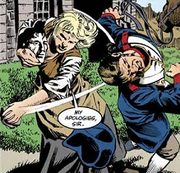Lady Johanna Constantine (1760-1859) was an 18th and 19th century aristocrat and adventurer, and an ancestor of John Constantine.
History[]
She was the daughter of Lord and Lady Constantine, orphaned at a young age when her parents were hanged for treason. Stripped of her title, she was forced to live in poverty. Her luck turned in 1785 when King George III asked her to retrieve Pandora's Box. If she succeeded, her title would be reinstated, and she would be given an estate. With success, her noble title was reinstated, and she came into possession of Blackwood Manor, which she renamed Fawney Rig.
In 1789, she crossed paths with Dream and Hob Gadling in a tavern, believing them to be the Devil and the Wandering Jew, who she had been told were the keys to achieving her dreams of power and wealth. Morpheus, however, subdued her with his sand, forcing her to see her past ghosts.[1] He later thought to use her as his tool, and presented her with an offer, the details of which were never revealed.

Rescuing Orpheus
On June 28, 1794, he came to Fawney Rig to call in that marker: she was to rescue his son, Orpheus, from the piles of dead accumulated during the Terror of the French Revolution. In this, she was successful, and when she passed away at the age of 99, Dream arranged for her burial on the island of Naxos, near Orpheus' temple, which was tended daily by Orpheus's priests.
Physical Appearance[]
Johanna is a tall, well built woman with long blonde hair often worn in long ringlets.
Trivia[]
- Lady Johanna was created by Neil Gaiman as a tribute to Alan Moore, who created John Constantine.
- Fawney Rig, which was the name Johanna bestowed upon her estate, was contemporary slang for a common fraud, as described in the Dictionary of Crime: A confidence man would drop a Lady's purse containing a cheap ring and wait for someone to spot it. He would then pretend to notice at the same time and claim half the loot for sharing in the discovery. The confidence man or an accomplice would appraise the ring at three or four times its real value, and offer the dupe his half of the find for about double its actual value. The key-word is the cant, fawney, meaning a finger-ring, a word brought to England by the Irish, synonymous Irish fáinne.
- The manor was previously owned by a Lady Blackwood, and after 1785, by Lady Johanna Constantine. In the early 20th century, it became the property of Roderick Burgess. Burgess used Fawny Rig as the base of operations for his occult organization, the Order of Ancient Mysteries.
